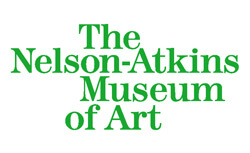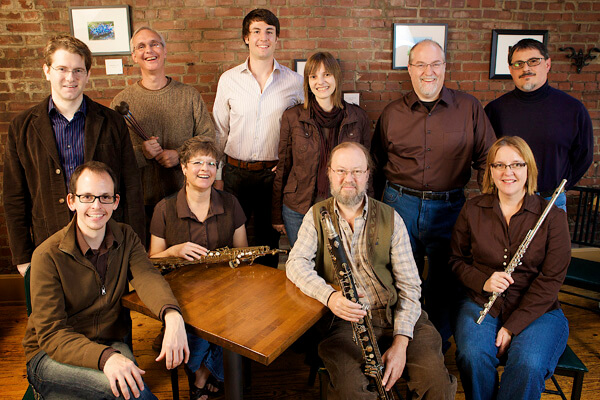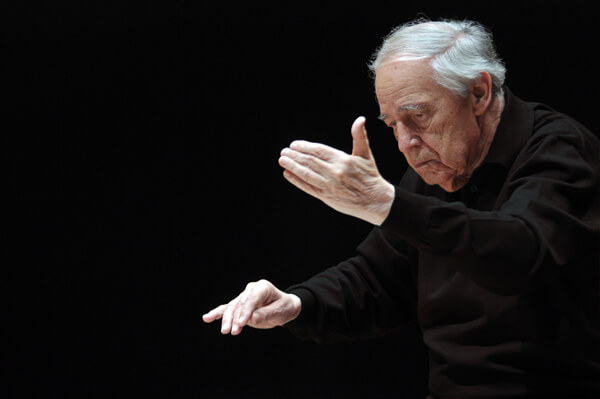 Now in its 21st season, newEar Contemporary Chamber Ensemble, Kansas City’s first and only professional new music ensemble, continues to challenge and delight listeners with concerts featuring landmark 20th century works and compositions hot off the press. “Luminosity” was the title and theme of their Friday, September 20, 2013 season-opening concert at the Atkins Auditorium in the Nelson-Atkins Museum of Art in Kansas City, Missouri. The six works chosen explored bright, shimmering colors, vibrant rhythms, and glowing timbres.
Now in its 21st season, newEar Contemporary Chamber Ensemble, Kansas City’s first and only professional new music ensemble, continues to challenge and delight listeners with concerts featuring landmark 20th century works and compositions hot off the press. “Luminosity” was the title and theme of their Friday, September 20, 2013 season-opening concert at the Atkins Auditorium in the Nelson-Atkins Museum of Art in Kansas City, Missouri. The six works chosen explored bright, shimmering colors, vibrant rhythms, and glowing timbres.

newEar Contemporary Music Ensemble – Photo by Scott Unrein
Max Grafe, born in 1988 and currently pursuing graduate composition studies at Julliard, demonstrates a compositional maturity beyond his years. His 2010 composition Moon Cycles opened the evening’s performance. Moon Cycles, inspired by the Italian Commedia dell’Arte tradition, uses an ensemble similar to that of Schoenberg’s Pierrot Lunaire: saxophone (replacing flute), clarinet, violin, cello, piano, and percussion. Grafe uses European jazz elements, snippet-echoes of Stravinsky’s Petrushka and Pulcinella, and a delicate blend of colors to portray the essence of the Commedia’s signature clowns Harlequin, Punch, Scaramouche, and Pierrot in six short interconnected movements. Bright, colorful, full of fascinating hues and instrument combinations, it was authoritatively performed by newEar. Moon Cycles is not a pastiche but a well woven tapestry of sound and program and a quite rewarding work that is worth getting to know, as is the composer.
Hanna Lash’s 2011 C for piano and vibraphone thoroughly explored the theme of luminosity. C‘s shimmering sounds, frenetic hammering and insistent, hypnotic rhythms, and it’s very title, beg comparisons to Reich’s iconic In C and there are surface similarities. But Lash’s C unfolds rapidly with new derivatives of the C-octave motive spinning from the core of this bright and vibrant six minute celebration of light. Robert Pherigo, piano. and Mark Lowry, percussion, were their usual technically and musically brilliant selves.
David Strober’s frequently performed Variations, written in 1998 for (and later recorded by) the eighth blackbird ensemble, concluded the first half of the program. In contrast to the previous works, Variations came across a bit more dramatic and serious, yet hardly dark or depressing. The six short variations grow organically from a five note sequence of close intervals, forming both melodic and harmonic foundations. As is to be expected, the usual fine coordination and spotless technique of newEar contributed to an excellent and well received performance.

Pierre Boulez (photo credit: A. Warme-Janville)
The second half began with Pierre Boulez’s Dérive 1 from 1984, derived from sketches for his earlier work Répons. Scored for flute, clarinet, violin, cello, vibraphone, and piano, Dérive is a short, delicate and glowing meditation. Such is the genius of Boulez that, coupled with the virtuosity of the newEar Ensemble under the direction of Steven Davis, the sheer volume of sonority from the sextet was amazing. Boulez’s music is often characterized as cold and somewhat mechanical, bereft of emotion. newEar certainly was calculating and precise, and yet their commitment to the music also allowed the gentle delicacy of the work to prevail. Especially moving were the last bars as the ensemble brought out an internal glow and allowed it to fizzle into the ether via a skittering violin figure. Boulez, in his recordings, tends to make this ending flourish abrupt and even a touch harsh. newEar’s softer, lighter final gesture was equally satisfying and appropriate. As fine as the evening’s other works were, the sheer perfection and economy of scale of Dérive was breathtaking and easily the concert’s highlight.
newEar’s resident saxophone virtuoso Jan Faidley, joined by pre-recorded fixed media, turned in a haunting and meditative Once Again to the Light by University of Missouri-Kansas City professor and newEar favorite James Mobberly. The fixed media, including recorded saxophone, serves as a ground over which the live saxophone at first blends in with and then slowly ascends to its climactic highest register as if trying to escape this world. Composed for saxophonist John Sampren, Once Again to the Light was also influenced by the life of Cameron Benjamin, the son of the composer’s friends who was stricken as a child with cancer. Faidley was magnificent, skillfully blending the saxophone with the media when called upon and then allowing the instrument to sweetly soar, without harshness or any tinge of screechiness, to the top. The composer, a devoted supporter of newEar, was in the audience to share in the enthusiastic reception.
“Luminosity” concluded with a major work, David Liptak’s Rhapsodies for Flute, Clarinet, Piano, Violin and Cello, under the direction of Steven Davis. In three connected movements, Rhapsodies evolves and flows from a single, simple melodic cell. The first rhapsody, marked “Con Forza,” is indeed an insistent, forward moving yet ultimately lyrical movement. “Lirico,” which follows, is immediately more sustained and relaxed, a flowing, languid nocturne. Flute and clarinet (NewEar stalwarts Thomas Aber and Lyra Pherigo) contributed wandering, lazy lines, colored by splashes from the piano and pizzicato strings. The final rhapsody, “Allegro Disinvolto,” is dance-like in character. Starting out a bit stilted and mechanical, the dance soon takes off, involving the whole ensemble, with flute predominant, until the piano alone pirouettes to the silvery conclusion.
Although their programs are challenging, perfectly executed and always engaging, newEar concerts are not formal occasions by any means. They are more like a family gathering and celebration. The enthusiastic audiences are diverse and loyal, casually dressed, and often include composers and musicians with international reputations. Stuffiness is left at the door and the celebration of new and exciting music is the only item on the agenda.




















